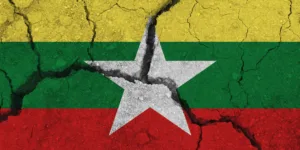February 1 marks the second anniversary of Myanmar’s coup d’état, a catastrophic event that plunged the country into turmoil and nullified its political transition. Two years later, while the international community has somewhat lost interest in the country, domestically the political-cum-armed conflict enters a new phase. The political question number one for 2023 is whether the junta will be able to organize a sham election to partially legitimize itself.
The coup
They came at dawn. On February 1st, 2021, the Tatmadaw (Myanmar’s armed forces) moved in to prevent Hluttaw (the parliament) from conveying and establishing a new civilian government formed by Aung San Suu Kyi’s National League for Democracy (NLD). The NLD had won general elections in November 2020 in a landslide. Although analysts may only speculate about the real reasons for staging the coup (the officially given reason of electoral fraud is laughable; the Burmese generals have never been good liars) one may look at this fourth coup in recent Myanmar history as a Tatmadaw-style conservative correction.
From the perspective of the military, or at least from its hard-core faction, things moved too far during the transition period in the 2010s. If memoirs of former military men and books by other insiders are to be trusted, Aung San Suu Kyi was not supposed to be the (central) part of the transition to ‘disciplined democracy’ (2010-2021). From the Tatmadaw’s point of view it was hoped that she would be (in the best case) a politically ‘dead tiger’ and (in the worst case) she should have been restrained by formal (constitutional) and informal checks and balances. But Suu Kyi maneuvered her way up to the top and was successfully changing the system from within. For the good of the country.
The Suu Kyi-Tatmadaw rapprochement produced the ephemeral Burmese Spring, a decade-long period of opening up, impressive reforms, quick economic growth, and societal high hopes. Although internationally the 2010s decade in Myanmar was overshadowed by the massacres of the Rohingya (in 2012, 2016 and especially in 2017), domestically it was the best period since the 1950s. Thanks to reforms, opening up, greater connectivity, an internet revolution, and the influx of foreign capital, the Burmese were living a better life (some much better, many a little better). No longer behind a bamboo curtain that separated them from the global world, with improved healthcare and education, strengthened NGOs and CSOs, and decreased Tatmadaw’s fantom menace in daily lives, many in Myanmar believed that despite the drawbacks and problems, things were going the right way. And then the military struck back.
The Spring Revolution
Despite the growing tensions between the military and civilians, the coup came as a shock to most people. The bewilderment was best illustrated by the viral story of Khing Hnin Wai’s aerobics against the background of armored vehicles moving to parliament. Once people realized that the military was back for good, they went on the street. February 2021 was a month of protests, with the peak point at the auspicious date of 22.02.2021 when over a million people demonstrated in defiance of the putsch. The protests, known since as the Spring Revolution, were both horizontal and diagonal in nature: they took place in almost all corners of the country and by almost every social group; they united the otherwise very divided society. It was a nationwide protest against the privileged ruling military class.
The generals should have been more prepared to stage the coup and could have waited out the afterward protests. But they have learnt nothing. Myanmar’s new junta, the State Administrative Council (နစက; SAC), responded in a typical traditional Tatmadaw way: by brutal force. The armed forces increased violence, including indiscriminate attacks on civilians, killing approximately 1,000 demonstrators and pacifying the peaceful revolution. This hasn’t quelled the resistance; instead, it led to chaos, economic catastrophe, and to a renewed civil war.
The Civil War
Historically speaking, the civil war in Myanmar is the longest-running armed conflict in the world. It always had two interconnected dimensions: intra-Bamar and Bamar vs. EAOs (Ethnic Armed Organisations). The former started in March 1948 with the rebellion of the Communist Party of Burma (CPB); the latter in January 1949 with the outbreak of Tatmadaw-Karen National Union (KNU) fighting. The communist rebellion lost its initiative in the late 1940s, since the Kunlong battle of 1972 ceased endangering the central plains but nonetheless shimmered for quite long, until the CPB’s demise in 1989. The ethnic civil war never ended, with periods of intensified fighting intertwined with ceasefire agreements. Currently there are between 15 to 22 EAOs opposing the central government, though historically speaking their numbers used to be much higher, around 150 in the 1970s. As of 2023, only some EAOs support the Bamar armed resistance (the PDFs, see below); others remain neutral or de facto pro-junta.
However improper it may sound (politically speaking) the intra-Bamar dimension has always been more important. The still present precolonial “mandala” or “galactic polity” logic dictates that the Burmese center of the country, the Dry Zone, in colonial times known as ‘Burma proper’, politically prevails over ethnic peripheries. Whoever dominates the Burmese heartland rules the country. And, reversely, a central government may live without controlling all ethnic regions, but losing a grip of the Dry Zone means a political game over. From this perspective, the Burmese center has been under the control of Yangon (and then by Naypyitaw) since at least the 1950s and completely since the early 1970s. Even the 8888 revolution and the 2007 monk protests haven’t changed that. The Tatmadaw’s hold on the Burmese heartland is only now being seriously challenged.
In May 2021, a shadow government, the National Unity Government (အမျိုးသားညီညွတ်ရေး အစိုးရ; NUG), was formed by the Committee Representing Pyidaungsu Hluttaw (ပြည်ထောင်စုလွှတ်တော် ကိုယ်စားပြုကော်မတီ; CRPH), a group of elected lawmakers and members of parliament ousted in the 2021 coup as well as other opposition politicians. Soon, Bamar-led domestic armed guerrillas or military militias, known collectively as People’s Defence Forces (ပြည်သူ့ကာကွယ်ရေးတပ်ဖွဲ့; the PDFs), sprouted throughout the country and started fighting with the Tatmadaw. In September 2021, an all-out war against the junta was declared by the NUG which (loosely) controls most PDFs. If initially the NUG looked more like a new NCGUB, and PDFs seemed to be another incarnation of ABSDF, then 2021 and 2022 showed that it was not the case.
After joining hands with some EAOs (especially KNU and the Kachin Independence Army, the KIA), the PDFs have survived the Tatmadaw’s brutal extermination campaigns in 2021 and 2022, a contemporary version of “four cuts” (a ruthless tactic from 1960s that does not distinguish between a civilian and a guerrilla). In 2022, PDFs emerged better armed and coordinated, capable of pressing the peripheries of junta-controlled areas, making the situation ‘serious but not desperate’ for the Tatmadaw. Undermanned and overextended, Tatmadaw forces that have to fight both the PDFs and EAOs had to withdraw from exposed positions in Rakhine and Chin states, struggle to control Sagaing and Magwe regions, have not pacified Kayah and face resistance in regions of Mandalay, Ayerawaddy, Taninthayi, Bago, and occasionally elsewhere (this map is a good indicator of the gravity of the situation). A recently leaked report from the Tatmadaw (if genuine) shows the scale of the challenge for the SAC junta. The NUG/PDF armed struggle is a truly national resistance against the military regime and supported (morally and financially) by the majority of the society.
At the same time, one should not take the NUG/PDF narrative at face value: the end of the Tatmadaw is still not in sight. The army is still much stronger, richer, much more numbered, better armed and coordinated. SAC still controls over half of the country, including the Burmese heartland with the most important cities of Naypyitaw, Yangon, and Mandalay, where SAC has established an ersatz of stability. Given the lack of verified data and information warfare from both sides, the reading of the current civil war is more of a glass half full or half empty interpretation. One may optimistically say the PDFs have not lost (and that is a victory in itself), but one may also claim that the junta is winning but has not yet won. What is certain is that this attrition civil war is going on and the tipping point has not yet been reached (or at least we are unaware of it). This struggle in 2023 will have an important political dimension.
The elections
The SAC junta wants to legitimize itself by holding sham elections. Even the generals understand that they would not win free and fair elections, so organizing this electoral spectacle is done for three interconnected reasons. First, the generals want to have a façade to make it easier for neighboring countries to normalize relations with military-ruled Myanmar. Any elections would give neighbors the much-needed excuse, no matter how imperfect. Second, the generals are tired of being called a junta or a military regime, and they would love to come back to Thein Sein’s good old days of window dressing. A Thai-style path to civilianisation is a tempting trendsetter. Finally, elections would be a show of political force by the Tatmadaw.
Given that the junta already changed the electoral system and handpicked the electoral commission, it can be safely assumed the elections will be a Burmese version of ‘those who count votes decide everything.’ That is, providing they will take place. The resistance movement will do everything to make it impossible to hold these ‘elections’. If the junta is unable to organize them, it will be a serious loss of face, a show of weakness instead of force (in the Burmese civil war, the psychological aspect is as important as the military one). That’s why organizing these grotesque ‘elections’ is more important than the (predestined) result: whether they will take place will be a litmus test of the real balance of power inside the country. Myanmar watchers, who since 2021 have been hopelessly trying to gauge the situation on the ground given the limited inaccessibility of the data, will finally have a cornerstone for their analysis. Meanwhile, all those who wish Myanmar democracy well find themselves in an awkward position of having to cross their fingers for an armed resistance that tries to prevent the organization of elections.







